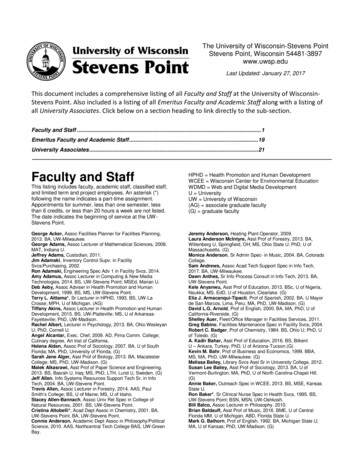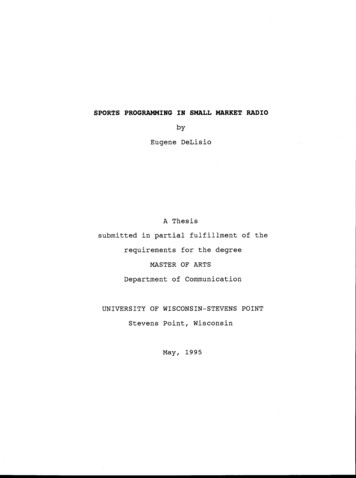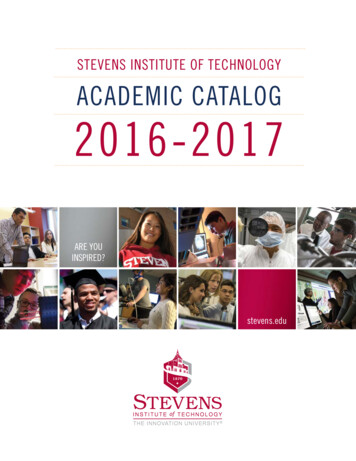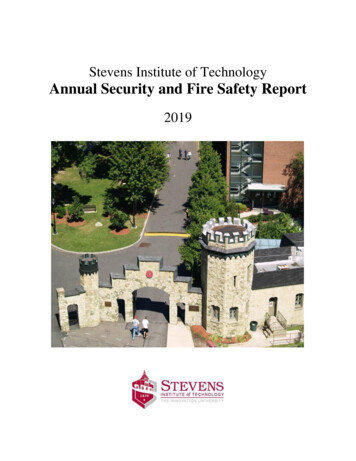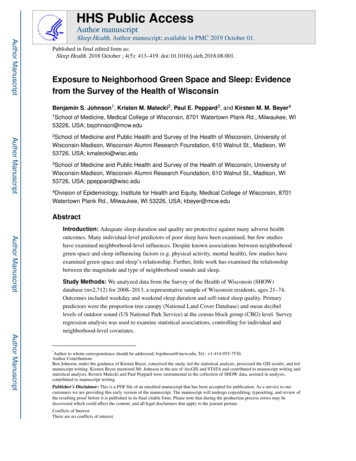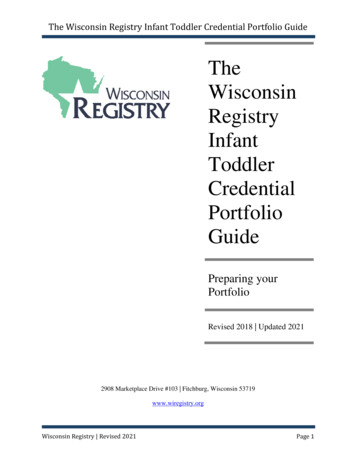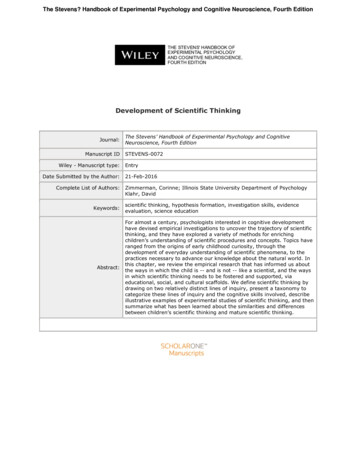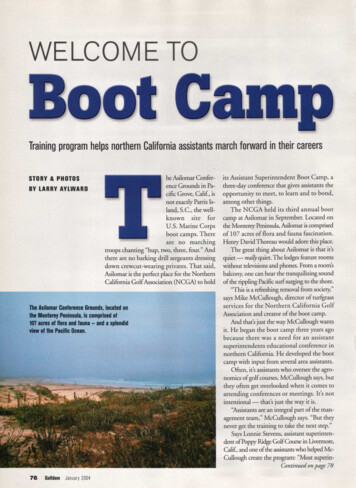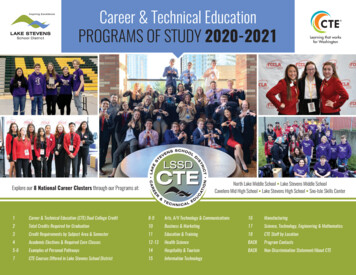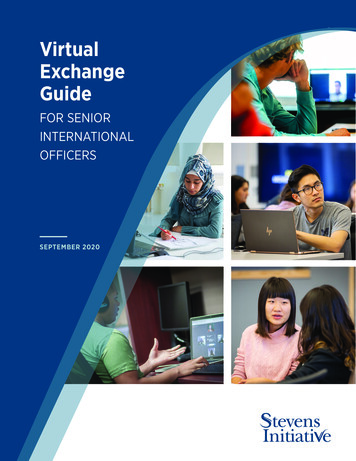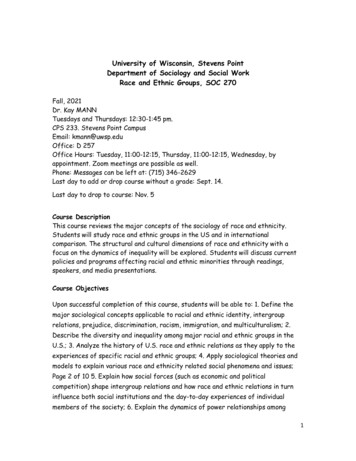
Transcription
University of Wisconsin, Stevens PointDepartment of Sociology and Social WorkRace and Ethnic Groups, SOC 270Fall, 2021Dr. Kay MANNTuesdays and Thursdays: 12:30-1:45 pm.CPS 233. Stevens Point CampusEmail: kmann@uwsp.eduOffice: D 257Office Hours: Tuesday, 11:00-12:15, Thursday, 11:00-12:15, Wednesday, byappointment. Zoom meetings are possible as well.Phone: Messages can be left at: (715) 346-2629Last day to add or drop course without a grade: Sept. 14.Last day to drop to course: Nov. 5Course DescriptionThis course reviews the major concepts of the sociology of race and ethnicity.Students will study race and ethnic groups in the US and in internationalcomparison. The structural and cultural dimensions of race and ethnicity with afocus on the dynamics of inequality will be explored. Students will discuss currentpolicies and programs affecting racial and ethnic minorities through readings,speakers, and media presentations.Course ObjectivesUpon successful completion of this course, students will be able to: 1. Define themajor sociological concepts applicable to racial and ethnic identity, intergrouprelations, prejudice, discrimination, racism, immigration, and multiculturalism; 2.Describe the diversity and inequality among major racial and ethnic groups in theU.S.; 3. Analyze the history of U.S. race and ethnic relations as they apply to theexperiences of specific racial and ethnic groups; 4. Apply sociological theories andmodels to explain various race and ethnicity related social phenomena and issues;Page 2 of 10 5. Explain how social forces (such as economic and politicalcompetition) shape intergroup relations and how race and ethnic relations in turninfluence both social institutions and the day-to-day experiences of individualmembers of the society; 6. Explain the dynamics of power relationships among1
racial and ethnic groups and how minority groups have negotiated the conditions oftheir marginalization in American society; 7. Demonstrate heightened sensitivity topolitical and cultural issues associated with race/ethnicity, gender, social class, andothers.Required Texts Recognizing Race and Ethnicity by Kathleen J. Fitzgerald. Routledge. 3rdEdition. Supplementary readings provided by instructor.Grading ScaleA 93-100A-90-92B 87-89B 83-86B- 80-82C 77-79C 73-76C- 70-72D 67-69D 60-66F 59 & belowEvaluation10% Paper #115% Quizzes (3x5%)15% Paper #2 Race and Ethnicity in the News.15% Paper #3. Intersectionality and Covid-19 paper15% Midterm Exam20% Final Exam10% Class Participation and AttendanceCourse PoliciesAttendance Policy: Attendance at all classes is mandatory.If you must be absent for personal or professional reasons it is your responsibilityto make up missed work. Missed exams may only be made up in case of emergenciesreported before the exam.Attendance penalties begin with the second absence. A fourth absence will lead tobeing dropped from the course or a failing grade.Late papers may be penalized 3% of assignment grade per day late.2
Academic IntegrityAll students are subject to university regulations concerning cheating andplagiarism. To ensure that the highest level of academic and personal integrity isupheld, it is important that you understand your rights and responsibilities as astudent at UWSP (see Academic Integrity: A Guide for Students). For a completeoverview of UWSP academic standards and disciplinary procedures, please visit: thefollowing website: aspxDisability ServicesConsistent with the Federal Rehabilitation Act of 1973, section 504, and the ADAact of 1990, any person enrolling in this course who may require alternativeinstructional and/or evaluative procedures due to a handicapping condition shouldfeel free to contact Disability Services and Assistive Technology at 715-346-3365 inRoom 609 Learning Resource Center at 900 Reserve Street. Staff will work to coordinatereasonable accommodations for students with documented disabilities. Please let me know ifI can assist in any way.Face covering requirement:Under the chancellor’s order, and in an August 9, 2021 email sent by ChancellorGibson that summarizes the order, “[A]ll students, employees and visitors to anyUW-Stevens Point campus or facility will be required to wear face coverings wheninside campus buildings and enclosed spaces with others outside of your household(e.g., in a UWSP vehicle). This policy is in effect until further notice.”Mandatory ReportingWe are deeply committed to finding ways to effectively prevent, reduce andrespond to discrimination and harassment, including sexual misconduct andinterpersonal violence. By asking all employees to report, we will be able torespond more effectively when a member of our community experiences suchmisconduct.Class EtiquetteCell phones, laptop computers, and other electronic devices are very disruptive soplease turn them off before coming to class. Texting is particularly disruptive. Ifyou use your laptop to take notes or you need your phone for an emergency, pleaseinform me in advance.3
The University of Wisconsin-Stevens Point occupies lands of Ho—Chunk andMenominee land and sacred land of all indigenous peoples.4
Topics and ReadingsWeek I: Introduction: What are Racial and Ethnic groups? Studying Race andEthnic Groups.Readings: Chapters, 1, Fitzgerald.Week II: Prejudice and Discrimination; Assimilation and Pluralism.Readings: Chapters 7, 11, Fitzgerald.Video Documentary: In Whose Honor?Week III: Whiteness, White Privilege, and Contemporary Debates about RaceReadings: Chapter 2, Fitzgerald; My Invisible Backpack, by Peggy McIntosh,on Canvas; Excerpts from Critical Race Theory, on Canvas.Paper #1, Personal Race/Ethnicity Experience.Due, Thursday, September 16.Week IV: Internal Colonization: Native AmericansReadings: Chapter 4, Fitzgerald.Video: In The White Man’s ImageQuiz #1. Tuesday, September 21.Week V-VI: Structured Racial Inequality: Black in America and BeyondReadings: chapters 5,6,9,10, Fitzgerald.On Canvas.William Julius Wilson, excerpts from “Jobless Poverty” on Canvas; “Class andRace Inequality, Health and COVID-19” by Kay health-and-covid-19/Film: Ethnic Notions.Paper #2, due September 30.Week VII: Immigration Ethnicity, and Racial Formation: Latin AReadings: Shaefer. “Hispanics: The Largest Minority”, Chapter 9; on canvas.From Rothenberg: “Becoming Hispanic: Mexican Americans and Whiteness”by Neil Foley, on Canvas.Week VIII: Immigration, Ethnicity, and Racial Formation: European EthnicGroups in Wisconsin.Readings:From Rothenberg: “How White People Became White”, by Barrett andRoediger, “How Jews Became White Folks.”5
Midterm Exam: Thursday, October 21.Week IX: Immigration, Exclusion, Model Minorities, and Ethnic Enclaves: AsianAmericans.Readings: Schaefer, Chinese and Japanese Americans. Readings: Chapter13.On Canvas; “The Chinese Exclusion Example, by Erika Lee,” “Neither Blacknor White” by Angelo Ancheta.Quiz #2. Thursday, October 28.Week X Immigration and Contemporary Racial Formation: MiddleEasterners/MuslimsReadings: Are Iranians People of Color? Persian, Muslims, and Model Minority RacePolitics, by Alex Shams; supplemental readings on Canvas.Week XI: Organizing against Racial Inequality.Readings: Chapter 6, Fitzgerald.On canvas.Paper #2. Contemporary News Analysis paper. Due, November 11.Week XII: Race and Ethnicity in International PerspectiveReadings:Chapter 3, Fitzgerald; “Not just an American problem, but a world problem”by Malcolm X. On Canvas.Quiz #3. November 18.Week XIII: Thanksgiving; No Class, Thursday, November 25.Week XIV; Race and Ethnicity in International Perspective, cont’dReadings on Canvas.Paper # 3. Due, Thursday, December 2.Week XV: ReviewReadings: Readings on Canvas.Final Exam: Monday, December 13. 2:45-4:45 pm.6
PapersPlease use APA or MLA citation style.Here is a link to the UWSP library website page on aper #1.10% of course grade.Personal Race/Ethnicity ExperienceDue, Thursday, September 16Language, religion, cuisine, family and marriage patterns, and attitudes towards thehome country are major components of the ethnic experience. Write a 5-7-pagefirsthand account about how these relate to your own experience as a member of anethnic group or a racial minority. Base your paper on your own experiences andfeelings as well as interviews with family members, especially from differentgenerations. Use this information, basic sociological concepts, * and yoursociological imagination to answer the following questions: What ethnic institutions have been involved? Has the old country been visited? What political, financial, emotional issuesmight be involved in such a trip? What evidence if any, have you seen of divisions within the community? Do some family members identify more with their ethnic origins than others?* Concepts include: Assimilation/Pluralism Marginality Principle of Third Generation Interest Endogamy/Exogamy Symbolic EthnicityPaper #1 Rubrics (1 D, 2 C,3 B,4 A)1) Clarity and Readability1-Unclear, poorly organized, multiple spelling and grammatical errors2-Basic organization, some spelling and grammatical errors3-Good presentation4-Excellent, clear, highly organized2) Handling of Questions1-Absent2-One or more used and applied inaccurately.7
3-At least three used and applied accurately.4-All four used and applied with high degree of precision.3) Use of Sociological Concepts1-Absent2-Some mentioned, vaguely applied3-At least three from concept list applied accurately.4-All five used and applied with high degree of precisionPaper #2. Analyzing Contemporary Race and EthnicityThis paper involves analyzing a current news article dealing with an aspect of raceor ethnicity using sociological concepts on race and ethnicity.1) Choose an article from the New York Times or Washington Post.2) Briefly, but thoroughly summarize the article.3) Relate at least three distinct concepts drawn from course material to thearticle.Paper #3. Research Paper. Due Thursday, December 2.It has been become increasing clear that African Americans and other minoritieshave been disproportionally harmed by the COVID-19 pandemic. This paper involvesexploring aspects of race that connect to the pandemic.Begin by reading the following paper that discusses the links between class, race,health, and COVID-19 linked here that I have recently lity-health-and-covid-19/ then,watch this TED talk by Professor Richard Wilkinson:https://www.youtube.com/watch?v AFOEe6M2VT4Then, write a 5-7-page paper that explores one or more of the points made in thearticle such as the links between race and class, class and health, race and health ingeneral. Choose one or more of these or other themes in the article, and expand onthem. Identify, cite and integrate into your paper1) Two peer reviewed articles.a. You are looking for general articles on the subject of race and health.Very little if any sustained research will be available yet on COVID19.b. Access peer reviewed articles through the libraries tab on UWSP’swebpage.2) At least one article from the New York Times or Washington Post.8
3) Any relevant information from the Wilkinson presentation.4) Course material where relevant.9
1 . University of Wisconsin, Stevens Point . Department of Sociology and Social Work . Race and Ethnic Groups, SOC 270 . Fall, 2021 . Dr. Kay MANN . Tuesdays and .
